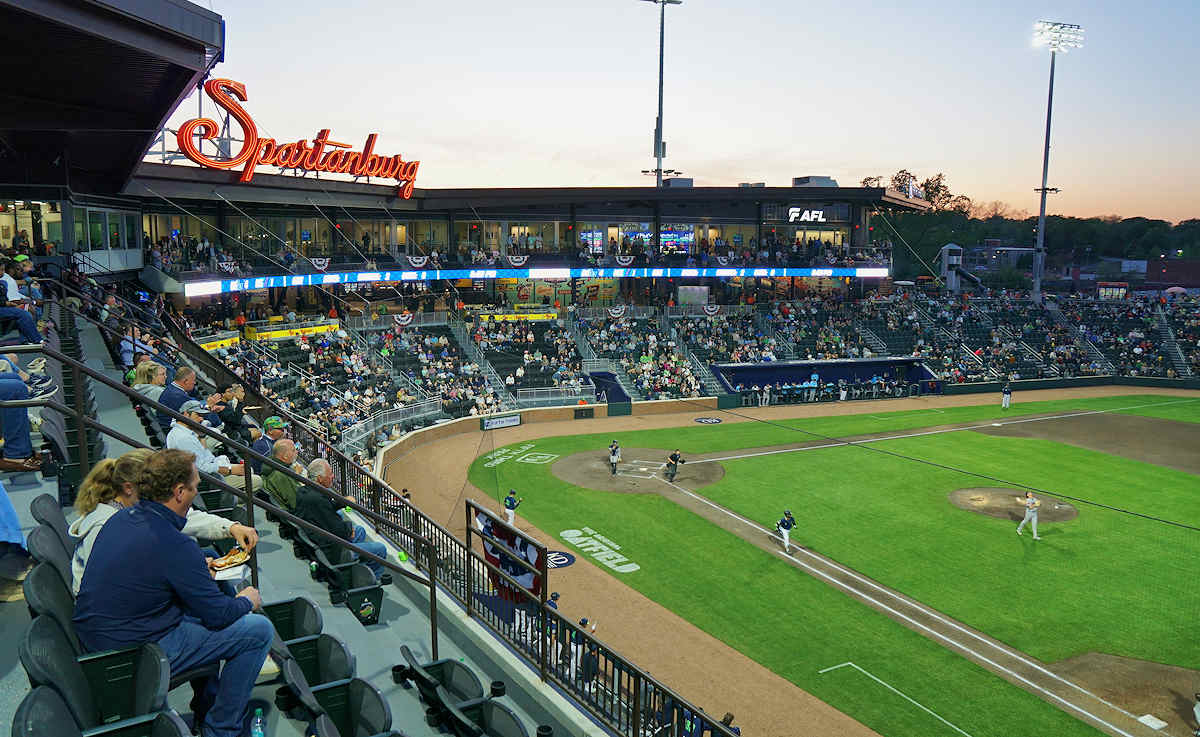
Article and photos by Joe Mock, BaseballParks.com
All rights reserved
SPARTANBURG, South Carolina Does your car or phone have an annoying GPS system? Is it always giving you warnings like “approaching a railroad crossing”?
| Ballpark Stats |
 |
| Team: Hub City Spartanburgers of the High-A South Atlantic League |
| First game: April 15, 2025, a 5-3 win over Bowling Green |
| Capacity: 5,500, with 3,500 fixed seats |
| Dimensions: LF – 328; CF – 410; RF – 327 |
| Architects: Overland Group started, McMillan Pazdan Smith finished |
| Owners representative: Canopy Team (John Whitty, project lead) |
| Construction: Robins & Morton |
| Price: $80 million, paid by the city, county, state, Diamond Baseball Holdings and Johnson Group |
| Home dugout: 1B side |
| Field points: north by northeast |
| Playing surface: natural grass |
| Naming rights: Fifth Third Bank, the 21st largest banking firm in the U.S. |
| Ticket info: Spartanburgers website |
| Betcha didn’t know: Railroad cars picked up grain from a mill that used to be where center field is today. |
When I use Waze, I get this warning frequently, even when there doesn’t appear to be any tracks. I just learned you can turn that alert off in the settings, but I’ve been too lazy to figure out how.
But I was sorely tempted to throw my phone out of my rental-car window when I visited Spartanburg to assess their new baseball venue. That’s because it seems like every street in town has railroad tracks crossing it.
Approaching a railroad crossing! Approaching a railroad crossing!
It wasn’t until I researched why the baseball team here chose to use “Hub City” as its geographic designation (rather than the name of the city) that it made sense why there were train tracks everywhere.
The first railroad came to the city in 1859. Over the next half a century, six different railroad companies brought lines here. On top of that, Spartanburg operated electric streetcars running up and down the main avenue called Church Street.
The city’s tourism website explains it like this:
The city limits were in the shape of a circle in the height of all of this railroad activity, and Spartanburg’s Union Station, sitting roughly in the center, was the hub of a wheel with the various railroads that led away from it as the spokes—so the Hub City was certainly a fitting name.
So that’s why the geographic designation of the team is Hub City. And most of those old tracks are still buried in the streets. Just ask Waze. And as we will see, one active line runs directly adjacent to the third-base side of the ballpark.
The team still managed to incorporate the city name into its nickname: Spartanburgers. It’s a name with endless graphic and merchandising opportunities to be sure, but “Hub City Spartanburgers” is a mouthful. Just like the burger with a huge fried green tomato on it that they serve at the concession stand down the first-base line.
When I inquired about why there’s an underscore at the end of the team’s X.com handle, more of this made sense. It was explained that they had to add the underscore because there was another baseball team in town — an entry in the Coastal Plain League — that had called itself the Spartanburgers in 2021, and they owned the X handle with no underscore.
I guess it was too much to hope for that there had never been another athletic team with that distinctive and colorful name.
Turns out that the name of their new park isn’t exactly original either.
| Duncan Park |
 |
| While Spartanburg’s Duncan Park has been used by a variety of teams during the last three decades, the last time an affiliated Minor League team was there was 1994. |
Fifth Third Bank, so named because a Third National Bank merged with a Fifth National Bank back in 1909, operates over 1,000 branches from Michigan to Florida. One recent ranking listed them as the 21st largest banking operation in the country.
They are certainly supporters of sports venues, having bought the naming rights to Fifth Third Arena in Cincinnati (where their corporate headquarters are located), Fifth Third Stadium in Kennesaw, Georgia, and Fifth Third Field in Toledo.
In the past, they also owned the naming rights to Camping World Stadium in Orlando, Day Air Ballpark in Dayton and LMCU Ballpark in West Michigan.
So if the name of Spartanburg’s new park sounds familiar, it should. By my count, it’s the seventh sports venue to feature the bank’s name.
So where did this franchise come from? And, no, it didn’t ride a train into town.
The Texas Rangers owned their Carolina League affiliate in Kinston, North Carolina starting in 2017. They called the team the Down East Wood Ducks, and they won (actually co-won) their only league title in their first season there.
As was the case with a number of Minor League franchises owned by MLB teams, the Rangers sold the Wood Ducks to Diamond Baseball Holdings in May of 2023. Likely because of the age and inadequate facilities at Kinston’s Grainger Stadium, DBH had no desire to keep the team there. They soon announced their intention to leave Kinston and move to a to-be-built facility in downtown Spartanburg.
| Down East |
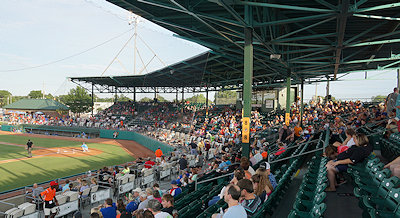 |
| The Spartanburgers were the Down East Wood Ducks through 2024. They played at lovely, quaint Grainger Stadium, built in 1949. Its facilities simply weren’t up to the new standards that MLB requires of Minor League teams. |
The market had been without affiliated Minor League baseball since the Spartanburg Phillies of the Sally League (the nickname usually applied to the South Atlantic League) played at the city’s Duncan Park through 1994. That franchise moved to Kannapolis, North Carolina in ’95. Today that team is known as the Kannapolis Cannon Ballers.
Now the level of Minor League Baseball for this new incarnation of Spartanburgers gets a little tricky, especially if you’ve followed the Minors for a while. The Wood Ducks were in the Carolina League, which was considered High-A. The Rangers’ Low-A team was also in North Carolina, as the Hickory Crawdads were in the Sally League. The brand-new ballpark in Spartanburg is light years better than the stadium in Hickory, so it made sense for that to be the home of the Rangers’ High-A team.
However, as part of Major League Baseball’s takeover of the governance of the Minors, MLBHQ deemed that the Sally League should become High-A and the Carolina League change to Low-A. So when the Wood Ducks played in Kinston, they were High-A Carolina League, and now that this same franchise is in Hub City, they are in the High-A Sally League. Hickory, meanwhile, was dropped to Low-A in the Carolina League.
Maybe Waze can explain all of this.
Anyway, let’s take a look at Fifth Third Park, starting with its setting, followed by its exterior and interior architecture (prepare for a bumpy ride) and its gameday experience.
The Setting
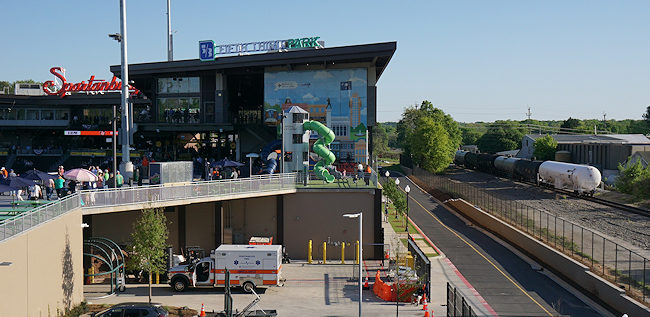
Hub City isn’t the town’s only nickname, by the way.
A local musical group called Joe Bennett and the Sparkletones had a hit song in 1957 called Black Slacks. The band appeared on a number of national TV shows, including The Ed Sullivan Show and American Bandstand. The folks from Spartanburg were so proud of the band that they adopted the nickname Sparkle City. In fact, if you happen to find yourself on the ground level hallway that leads to the locker rooms and dugouts, you’ll spot a mural that proudly proclaims that nickname.
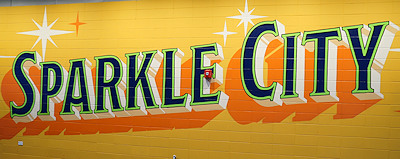 So what do we know about Hub/Sparkle City?
So what do we know about Hub/Sparkle City?
Its population of 38,732 makes it one of the smaller cities to host affiliated Minor League Baseball. That’s a little misleading, because it’s double the population of Kinston … plus its metro area is pegged at 383,327. This does not include the city of Greenville, South Carolina, which has a downtown that is only 30 miles away.
If Greenville rings a bell, that’s because it’s home to another South Atlantic League team, the Greenville Drive. Given the proximity of the two teams, wasn’t there a territorial conflict when Diamond Baseball Holdings wanted to move a team to Spartanburg? “There were definitely conversations with everyone involved, but we were all able to understand that there is enough distance” between the two ballparks, noted Spartanburgers’ GM Tyson Jeffers. If you look at a map, the two cities look close, but when you try to drive from one to the other, it can easily take an hour. “So the actual travel distance creates some separation organically.”
Jeffers is a great admirer of the Drive franchise. “We have to give credit where credit is due, because they’ve set a standard of building a ballpark in an area of a downtown that needed some help. When you look at that area (in Greenville) now, it’s just unbelievable. We hope to replicate that here.”
He likes that the two teams are in the same league. He notes that the two cities have always had somewhat of a natural rivalry with each other. “And now our teams can have a rivalry, too.”
One reason Greenville’s team is named the Drive is because the automotive industry is huge in this area. BMW employs about 11,000 workers at a complex roughly halfway between the two cities. With all of the suppliers and companies related to BMW, all told there are over 100 firms in this industry in the “upstate” area of South Carolina, employing about 30,000 people.
Considering the Greenville/Anderson metro area has nearly a million residents, when you add that to the 383,000 in Spartanburg, yes, there is enough population and commerce to support both franchises.

Fifth Third Park seems to sit pretty much by itself down a hill from downtown Spartanburg (above), but that is only temporary. Johnson Group is a key member of the team of entities that brought the Wood Ducks franchise to town, because they have plans for a major mixed-use development worth about $500 million in the blocks surrounding the park. The first new business to open in this neighborhood is the AC Hotel by Marriott, which is just up Daniel Morgan Avenue from the ballpark.
This neighborhood has a name, and it may very well be attached to the overall development, the way The Battery is the name of the stores, hotel, apartments and restaurants just outside of Truist Park in Atlanta.
That name is the Grain District. There is a very good reason for this. On the exact spot where the Spartanburgers play today there were grain mills. “The railroad tracks that run right outside our park’s walls (see photo at the top of this section) actually used to spin into the land where center field is now,” explained Jeffers. “Train cars would get loaded up with grain and materials and then they’d be on their way.”
The photo below shows those active tracks close to the park’s home-plate entrance along Henry Street.

So the hotel, a beautiful parking garage and the ballpark arrived on the scene at roughly the same time. The next structure in the development will be an office building just to the north of the garage. After that, the plans are still taking shape, but there are a number of parcels of land just beyond the outfield’s fences that will be prime spots for restaurants and perhaps apartments.
The Grain District Development “is going to have a tremendous impact,” Billy Dunlap, Chief Tourism Development Officer of One Spartanburg, told me. “It’s already becoming a destination for not only people who live in Spartanburg County, but people who live in the surrounding area.”
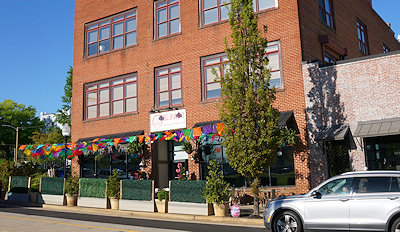 I can’t wait to come back in a few years and see how everything turns out. If the residential element is half as nice as what surrounds Knoxville’s new ballpark, it will be beautiful. “As the Grain District builds out, it will be a great place to live, a great place to play and a great place to visit,” notes Dunlap.
I can’t wait to come back in a few years and see how everything turns out. If the residential element is half as nice as what surrounds Knoxville’s new ballpark, it will be beautiful. “As the Grain District builds out, it will be a great place to live, a great place to play and a great place to visit,” notes Dunlap.
In the meantime, there are a couple of restaurants within walking distance, notably El Paso Tacos and Tequila (see photo), which is (for now) visible from within the park. One can almost hear the radio voice of the Spartanburgers, Ian Unsworth, describing a long home run beyond the center field wall as “being hit to El Paso!”
One other point of interest that you should visit downtown is the Hub City Railroad Museum, less than a mile north of the park. Its entrance on Daniel Morgan Avenue features a cute red caboose and a historical marker about the railroad history of the city.
Says Dunlap, “If you want to understand the true meaning behind the Hub City name, then (the museum) is a definite stop to learn the history and what that name means to the people in this community.”
The Exterior

I have several beefs regarding the architecture of Fifth Third Park, but they involve missteps on the interior of the park. There is nothing wrong with the structure’s exterior.
Let’s start our look at the outside of the park behind home plate (above). The building materials used make perfect sense, and the entry here is lovely. I just wonder if it was worth the effort since only a tiny percentage of fans will enter the ballpark here. It’s not near any of the parking or, for that matter, any of the coming development beyond the park’s outfield.

The use of brick — all over the park — is well-done, and one assumes that this look will be compatible with the apartment buildings and commercial buildings in the Grain District development. While there is nice masonry work on the main structure behind third base (above), most fans (unless they are riding on top of a freight car on a train going by) won’t see it. More folks will see the exterior on the first-base side (below), and that is just as nice. The glass at the far end is where the Milliken Club is located. More on that beautiful space later.
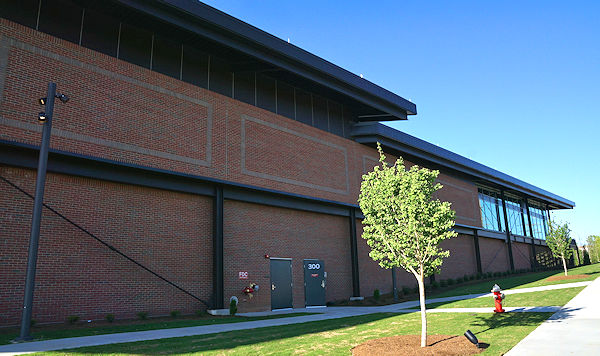
One of the entities involved in creating the ballpark was Canopy Team, a consulting firm started by the legendary Janet Marie Smith. John Whitty and Jackie Riggleman from Canopy worked closely with the Spartanburgers’ front office in making final design decisions. They recognized this issue with entry points. “The home plate (gate) faces a railroad,” remarked Riggleman. “So we knew going in that the left-field and right-field entries are going to be the most used. That’s where the energy and action belonged.”
Indeed, those entries, one by each foul pole, are well thought out. The left-field gate is the most-used, since it is adjacent to the beautiful new parking garage. Here there’s a cute plaza with a human-size bobblehead that makes a great photo opportunity. This is also where one of the two merchandise stores is located, on the ground floor of the garage. By the way, I recommend going to the top of the garage for the view. You can see the ballpark beautifully as well as the surrounding countryside.
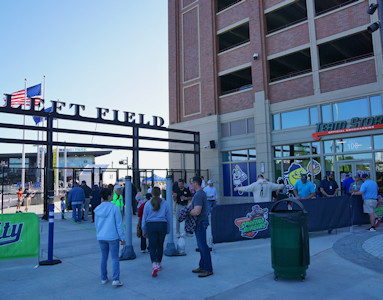 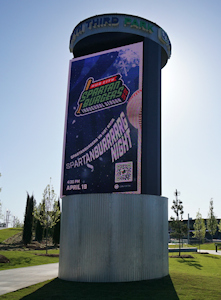 |
The right-field gate isn’t as elaborate, but there are nice video boards (above) with info helpful to fans heading to a game.
At this point, there isn’t a lot to see regarding the exterior beyond the outfield walls. I assume this will look much different when the development is constructed.
Be sure to click to the next page to see what the interior of Fifth Third Park is like. There are highlights — and a couple not — inside.